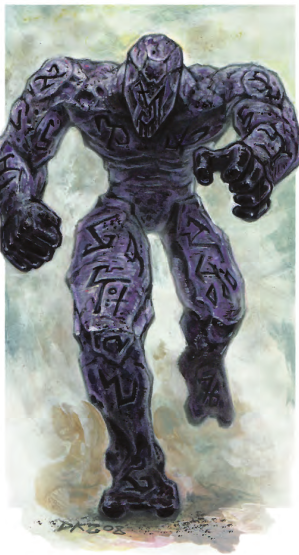Let's Read the 4e Monster Manual/Vault: Eidolon

This article is part of a series! Click here to see the other entries.
I hadn’t heard of eidolons before Fourth Edition, but I seem to recall the word was used in 3.x too. They are only on the Monster Manual.
The Lore
Eidolons are intelligent constructs created through divine magic. The ritual for their creation involves a crystalized spark of divinity which is buried deep into the eidolon’s structure. While the one from the illustration is a somewhat abstract humanoid, I imagine they’re frequently built in the shape of the deities their creators worship.
Eidolons are considered more than simple tools - they also serve as a symbol of their creator’s devotion. Sometimes, though, that spark of divinity inside the eidolon goes bad, which causes the creature to suffer from delusions of godhood and to act with murderous intent towards anyone who disagrees.
If all of this sounds familiar it’s because it’s somewhat similar to the lore for D&D clay golems - constructs created by divine magic who sometimes go berserk and turn on their creators. The main difference here would be one of purpose. While clay golems are traditionally mindless solitary guardians, eidolons are built to support and inspire their correligionists, and so are always found among the faithful. It also helps that clay golems are absent from this book.
The Numbers
Eidolons are Large Natural Animates with the Construct keyword, and Level 13 Controllers (Leaders) with 132 HP. They project an aura of fearlessness out to 5 squares, rendering any allies within immune to fear. As constructs, they are themselves immune to fear, disease, and sleep. They walk with speed 5.
Their basic attack is a slam, but it’s not the main thing Eidolons do. They’re all about divine pyrotechnics. When one of their allies is slain in the eidolons’s line of sight, they lash out with Vengeful Flames as a reaction. This is a Ranged 10 attack that targets Reflex and does both immediate and ongoing fire damage. It does not provoke opportunity attacks.
As a standard action the eidolon can assume a Hallowed Stance, which I guess makes it look like a normal idol statue. While in this state it gains resist 20 to all damage, and any allies in its line of sight gain +1d8 damage to all their attacks. The stance lasts for a turn and ends immediately when the eidolon moves. That last bit is just another way to say it can keep Hallowed Stance up indefinitely as long as it remains perfectly immobile and does nothing else.
If anything attacks the eidolon while it’s maintaning Hallowed Stance, it smites the offender as a reaction with Divine Retribution which has Range 20, targets Reflex and does radiant damage (half on a miss). Like Vengeful Flames, it does not provoke opportunity attacks.
Sample Encounters
There are two:
-
Level 11: 1 eidolon and 4 githzerai cenobites. I guess it’s a statue of Zerthimon.
-
Level 13: 1 eidolon, 2 grimlock berserkers and 1 medusa warrior. I got nothing on this one.
Final Impressions
Surprisingly atmospheric! Despite the similar lore, eidolons play very differently from clay golems. Golems are agressive bruisers; eidolons want to remain completely still during the fight and let their reaction and passive powers do the work. It’s quite possible for the party to not realize they’re dealing with an eidolon until the Vengeful Flames begin to kick in when the other monsters drop.